For new players of Black One Blood Brothers, this guide breaks down general gameplay basics and offers key tips and tricks for success. Lets dive in.
Introduction
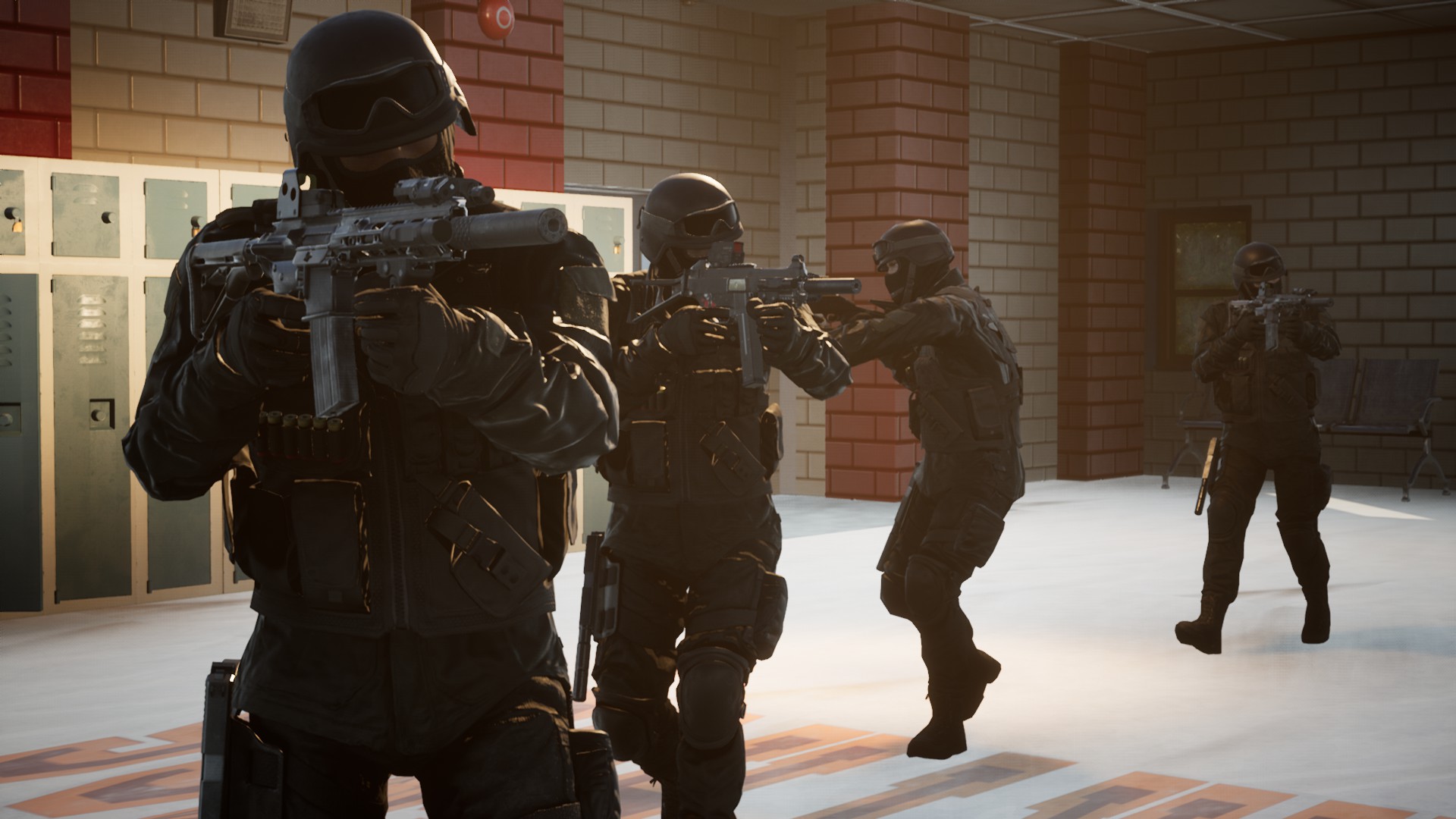 Black One Blood Brothers is a highly ambitious game with a lot of moving parts. It can be hard to keep track of what each of those parts does, especially when they don’t always play nice together as the game goes through early access. This guide is designed to help you with some gameplay mechanics and tricks you might not have picked up on from the tutorial and loading screens alone.
Black One Blood Brothers is a highly ambitious game with a lot of moving parts. It can be hard to keep track of what each of those parts does, especially when they don’t always play nice together as the game goes through early access. This guide is designed to help you with some gameplay mechanics and tricks you might not have picked up on from the tutorial and loading screens alone.
Current game version of this guide: 1.46
Getting Started: Play the Tutorial
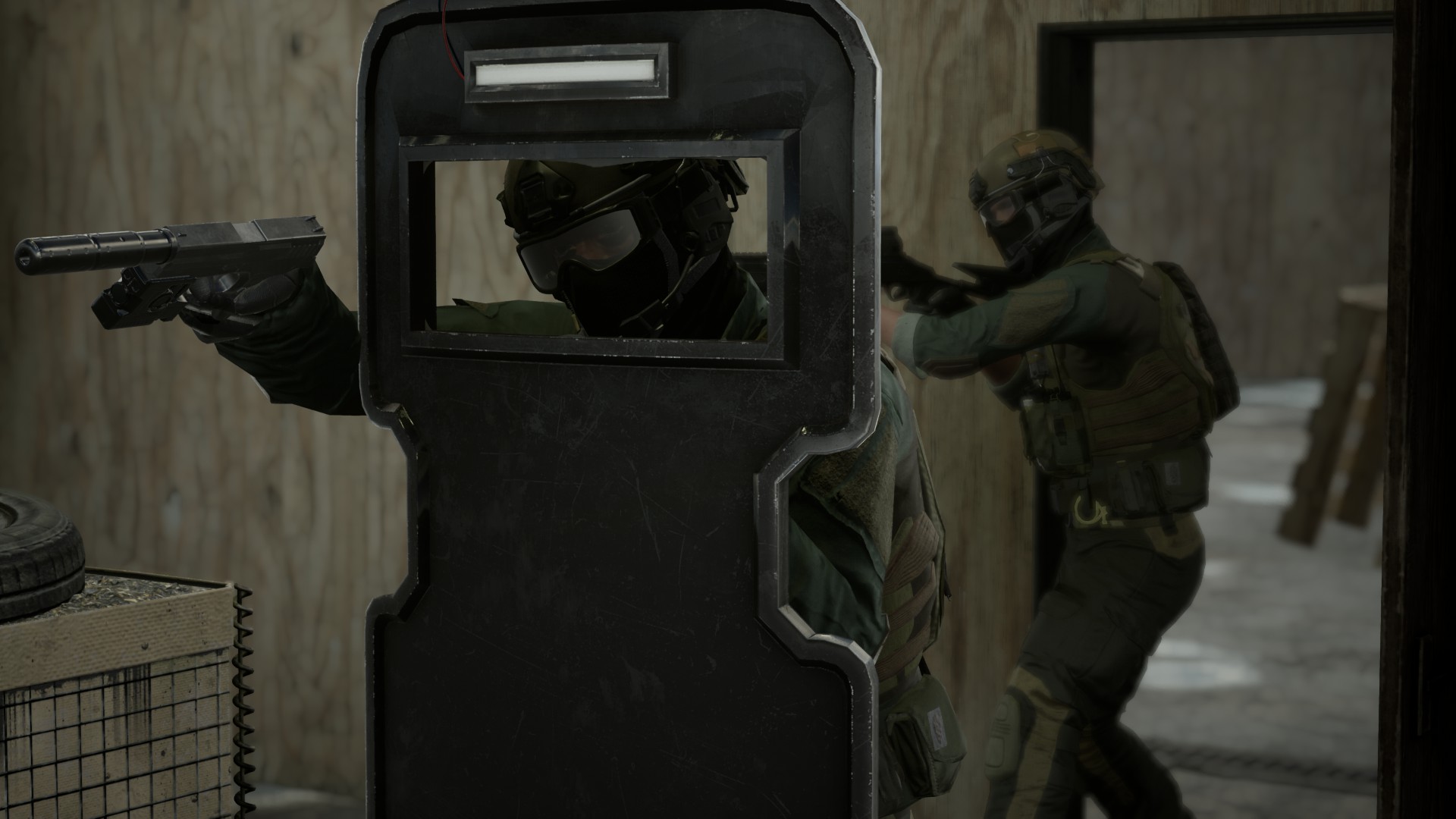 Seriously, play the tutorial. It absolutely dumps information on you with very short examples making it hard to commit every little thing to memory but learning your core actions, how to use the battle plan, and quick orders is absolute necessity. Run yourself through, get an idea of what your operator and team is capable of, then we can really get started.
Seriously, play the tutorial. It absolutely dumps information on you with very short examples making it hard to commit every little thing to memory but learning your core actions, how to use the battle plan, and quick orders is absolute necessity. Run yourself through, get an idea of what your operator and team is capable of, then we can really get started.
Before you really dive into tier one operating, one thing that is worth looking at is squad creation and composition. If you’ve absolutely no interest in this, feel free to skip the next section but I find it both worth doing and fun.
Creating Your Squad: G.I. Joe & Jane
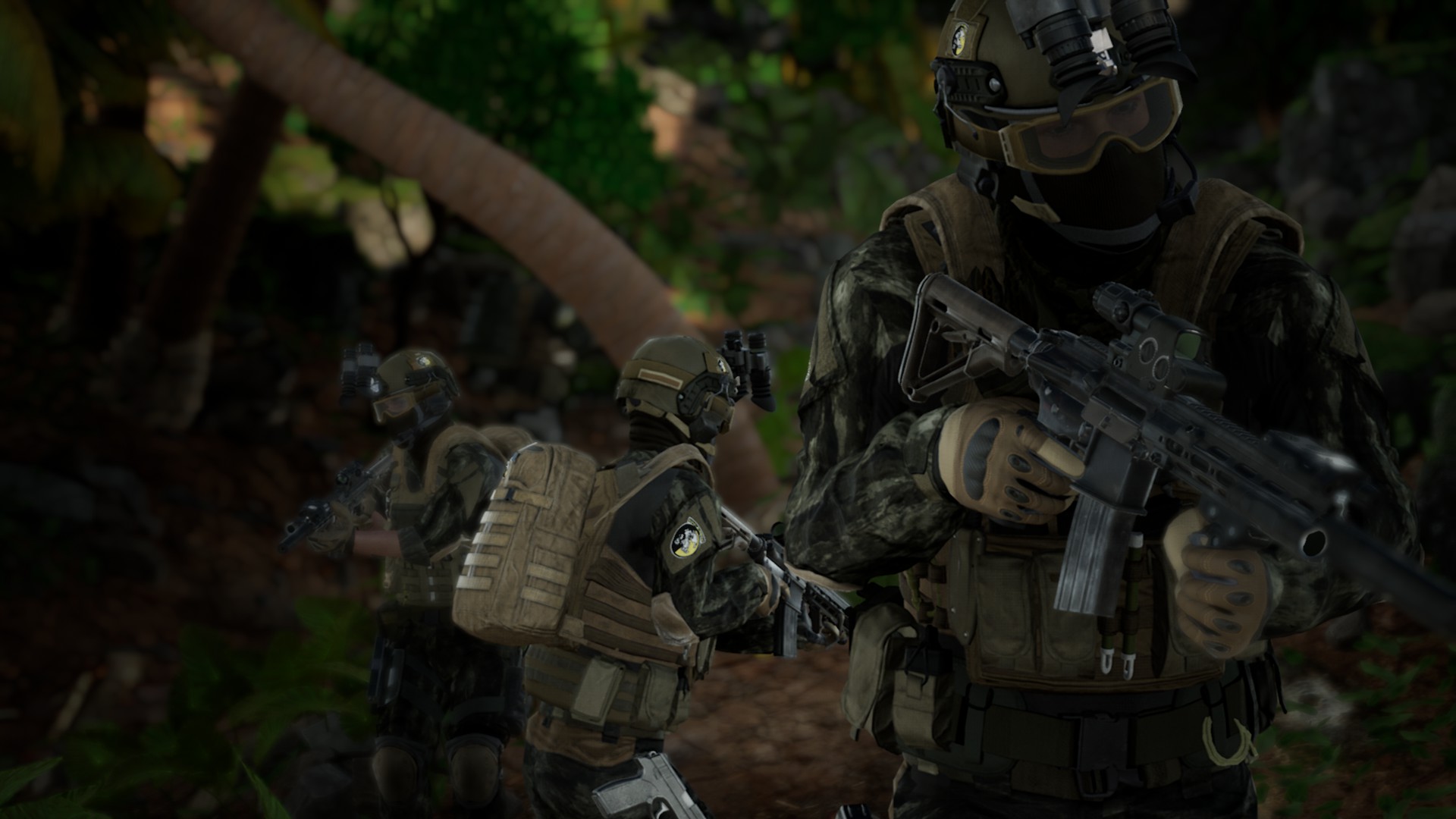
While the default cadre of operators is perfectly capable, you’d be remiss not to take the time to sit down, play some operator dress-up, and even do some min-maxing while you’re at it. At the end of the day, they’re your dudes and you should feel free to customize and build them to your liking. Whether you prefer a squad of high speed, low drag operators who fill very specific roles or a bunch of bumbling, ghille-clad barbarians waving around shotguns is totally up to you. Either way, let’s talk about what makes a squad tick.
-
Assault
This governs a soldier’s capability with weapons that use a sight classified as a magnifier or weapons without accessory sights. Confused as to what counts as a precision scope and what doesn’t? Sights are categorized into magnifiers and scopes. This skill applies to any weapon equipped with a magnifier or not equipped with a sight at all.
-
Sniper
This governs a soldier’s capability with weapons that use a sight classified as a scope (classified as a precision scope).
-
Medicine
This governs how quickly a soldier can heal themselves or a teammate and how quickly they can revive downed teammates.
-
Demolitions
This governs how quickly a soldier can plant and defuse explosives.
-
Electronics
This governs how quickly a soldier can hack a computer and call in air support over the tactical command bridge.
-
K9 Training
This governs the concentration time (the total amount of time you can operate the dog in one session) a dog in the soldier’s control has.
-
Survival
This governs how long the bleedout timer is for a soldier who is downed and how much an injury affects their combat capability.
-
Stealth
This governs footstep noise made by the soldier, essential for staying undetected in CQC.
-
Stamina
This governs how long a soldier can sprint.
-
Carrying
This governs how much a soldier can carry. Don’t sleep on this one. Keeping a soldier in green weight as opposed to orange or red increases their combat efficiency.
What can you bring? What should you bring? The answer to both questions is a lot. Here’s a look at what your operator can take with them into the field.
-
Assault Rifles
The bread and butter of your squad. These weapons can be split into two general categories: carbines and long guns. Carbines have shorter barrels and generally less velocity and damage, making them more ideal for close range engagements such as breaching doorways. Long guns have higher velocity and damage but the length of the barrel can make getting on your target after rounding a corner challenging. How do you tell which is which? Look at the guns and compare. If it’s short, it’s a carbine. If it’s long, it’s a long gun. These weapons can also be equipped with underslung grenade launchers as well as magnifiers and scopes, making them tactically versatile.
-
Machine Guns
These weapons can get a high volume of fire on a target in short time as well as having large magazine capacities. However, be wary of their weight. Not only does the firearm itself have some impressive mass, the ammunition it requires isn’t easy to carry around.
-
Submachine Guns
These automatic weapons are very short, making them ideal for CQC engagements. Enter doorways, lean around corners, and stack up without fear of not having room to actually get your sights on target.
-
Shotguns
Pump-action firearms that can deal a significant amount of damage at close range, these are ideal for making sure the first target you snap to indoors is dead after a single pull of the trigger. More over, they can destroy doors easily if you need to make a quick entry or open a new line of fire. Be advised: these weapons cannot be suppressed so consider keeping them holstered until you plan to go loud.
-
Sniper Rifles
These are high damage, high velocity, low capacity weapons ideal for taking out enemies at long range. If an enemy is well out of your squad’s average engagement range, one of these can solve that issue for you. Best equipped with a scope and a bipod as opposed to a magnifier and a grip.
-
Pistols
Out of bullets for your primary firearm? Entering close quarters and all you thought to bring along was a sniper rifle? Need to get around a doorway and get sights on target quickly? The pistol is a reliable fallback weapon for when your primary weapon does not meet the necessities of your current engagement.
What can you put on that firearm? Things that make it better, that’s what.
-
Magnifiers & Scopes
These are better than ironsights in nearly any situation unless you’re really concerned about peripheral vision. However, there is a difference between magnifiers and scopes. Weapons equipped with magnifiers are better used by operators with high assault skill while weapons equipped with scopes are better used by operators with high sniping skill. When choosing your sights, make sure to consider the magnification a sight provides, if it provides dualsight (the ability to switch from a magnified sight to a non-magnified sight), and if it has night vision or thermal capability. With true aiming on, you cannot use sights with NVGs active, keep that in mind.
-
Lasers & Flashlights
Lasers and flashlights come in two categories: standard and IR. Standard lasers and flashlights can be seen without NVGs while IR lasers and flashlights can only be seen with NVGs. Many of these attachments have both lasers and flashlights combined that can be used standard or in IR. Pay attention to the description to see if it has a laser, a flashlight, and if it’s IR capable. If using NVGs in close quarters with true aiming enabled, you will not be able to use your weapon sights and thus an IR laser is essential for point shooting. Be advised: enemies equipped with NVGs such as the Dark Army will be able to see your IR lasers and flashlights.
-
Underbarrel Attachments
Grips, bipods, and grenade launchers go here. Grips provide better aiming stability, bipods provide massively better aiming stability only when prone, and grenade launchers launch grenades. Do note that you have to bring ammo for your grenade launcher if you intend to have one.
-
Silencers
These exist to prevent your operation from going too loud too soon. Essential if you want to play it smart and keep it quiet. Every weapon but the shotguns can be silenced.
Creating Your Squad: Things That Are Not Guns
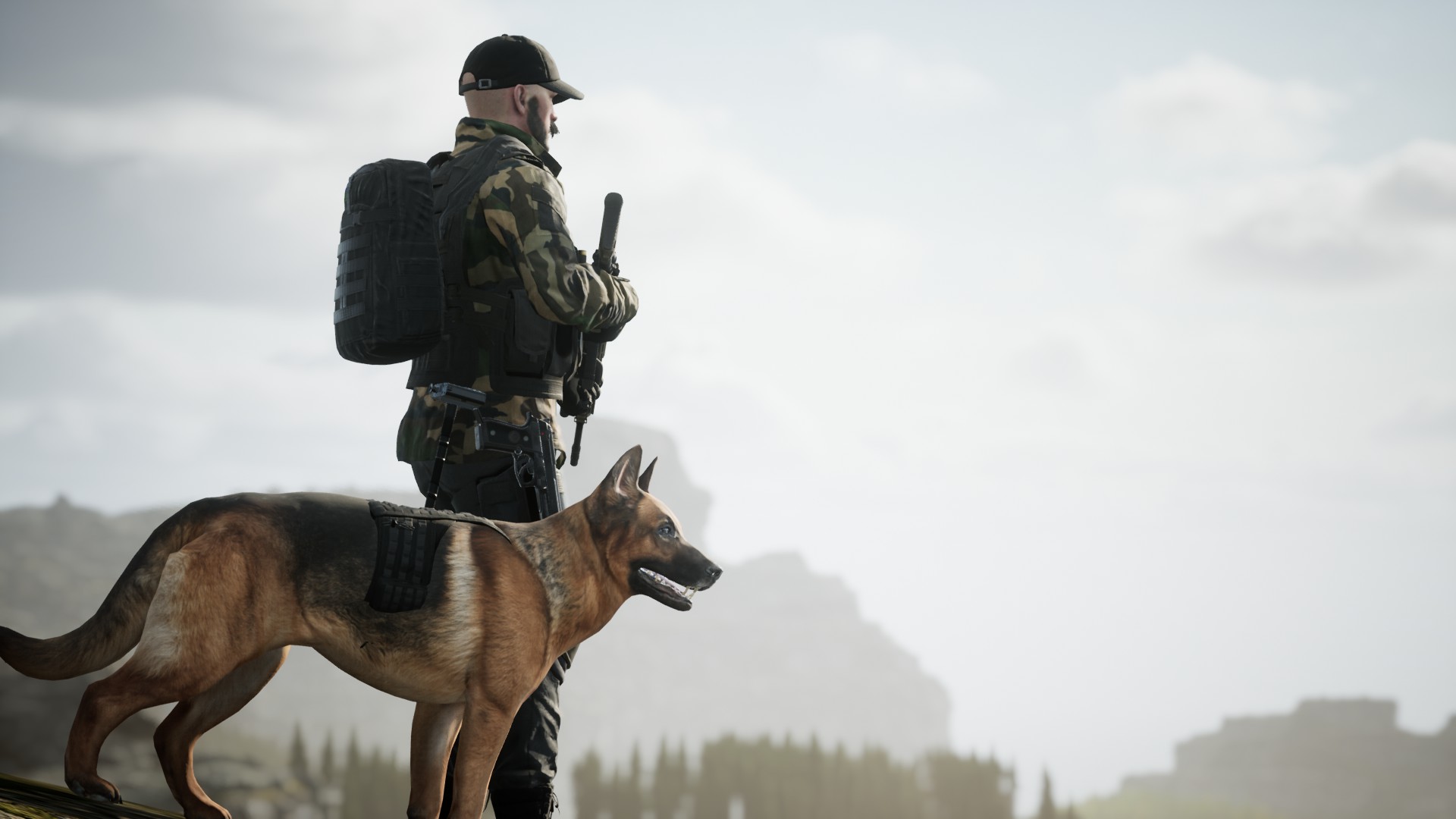 Firearms are not the only things your squad can bring. Let’s break down their other tactical options.
Firearms are not the only things your squad can bring. Let’s break down their other tactical options.
Want to make stuff more deader? These are how you do it.
-
Explosives
There are a variety of explosives with different situational use. When choosing your explosive, ask yourself this: do I want to kill someone or blow up an object? While C4 is ideal for destroying mission objectives, don’t sleep on anti-personnel devices. If you start playing with higher enemy density, these explosives can go a long way to securing your position if you find yourself holding out against an alarmed force.
-
Throwables
There are four main types of throwables: frag grenades, smoke grenades, flashbangs, and chemlights. Frag grenades blow people up. Smoke grenades provide concealment, blocking enemy view. Flashbangs can stun and blind enemies. Chemlights can be used to mark rooms and even come in an IR form that can only be seen with NVGs if you don’t want the light to give you away.
There’s more that you can bring that just firearms and explosives. Let’s look at the gear that can make you more tactically flexible.
These kits allow your operators to perform unique actions that expand your capabilities.
-
Defuse Kit
This kit allows an operator to defuse traps and bombs.
-
Electronic Kit
This kit allows an operator to hack into computers and disable power.
-
Lockpicking Kit
This kit allows an operator to open locked doors and windows silently.
-
Break-in Kit
This kit allows an operator to open locked doors and windows loudly.
-
Electrocution Handcuffs
This kit allows an operator to take prisoners.
-
Tactical Voice Bridge
This kit allows an operator to call in air strikes, supply drops, and aerial recon.
-
K9 Handler Kit
This kit allows an operator to bring along a canine companion who can detect explosives and silently take down enemies.
There are three types of medical packs: trauma kits, first aid kits, and tactical medical kits. Trauma kits allow healing to be performed on yourself or a teammate twice. First aid kits allow one revive of a downed operator or enemy for capture. Tactical medical kits have a combined pool of twenty charges for healing and reviving but are very heavy, best suited for a dedicated medic. It’s this author’s opinion that every operator should at least have a trauma kit.
“This is yours for when you need it.”
Drones can be used to scout areas in advance and mark enemies. They are classified by their top speed, their total battery life, how far they can fly from the operator, the noise they make, and if they are capable of night vision and/or thermal imaging. Be advised, the better drones are louder and much heavier.
These incredibly heavy slabs of metal can stop bullets entirely but reduce an operator’s movement, vision, actions they can take, and also relegates them to a pistol when in use.
NVGs and thermal imaging systems have three important factors to consider: vision modes, optic type, and weight. These can either see in nightvision, thermal, or both. The amount of vision (or obscuring thereof) is determined by the amount of lenses it has with quad-nods having the best available FOV and single-lens systems having the least. Just like with drone, better systems are much heavier.
Binoculars can be used to get eyes down range before approaching. They all have the same zoom capability so what differentiates them are vision modes (night and thermal) and the addition of a rangefinder. As before, nicer sets of binoculars weigh much more.
These are used to silently take down enemies from behind. There is no difference between them, choose the one you think is coolest.
Let’s take a moment to talk about weight. Lower weight is better, needless to say. When creating your operator’s kit, keep in mind that a high weight will influence their mobility and accuracy as well as fatiguing them more quickly which can doubly reduce their combat efficiency. Don’t bring the kitchen sink, take what you need.
“Anything you need, you can find in the field. If you can’t find it, you probably didn’t need it.
Creating Your Squad: Combat Roles
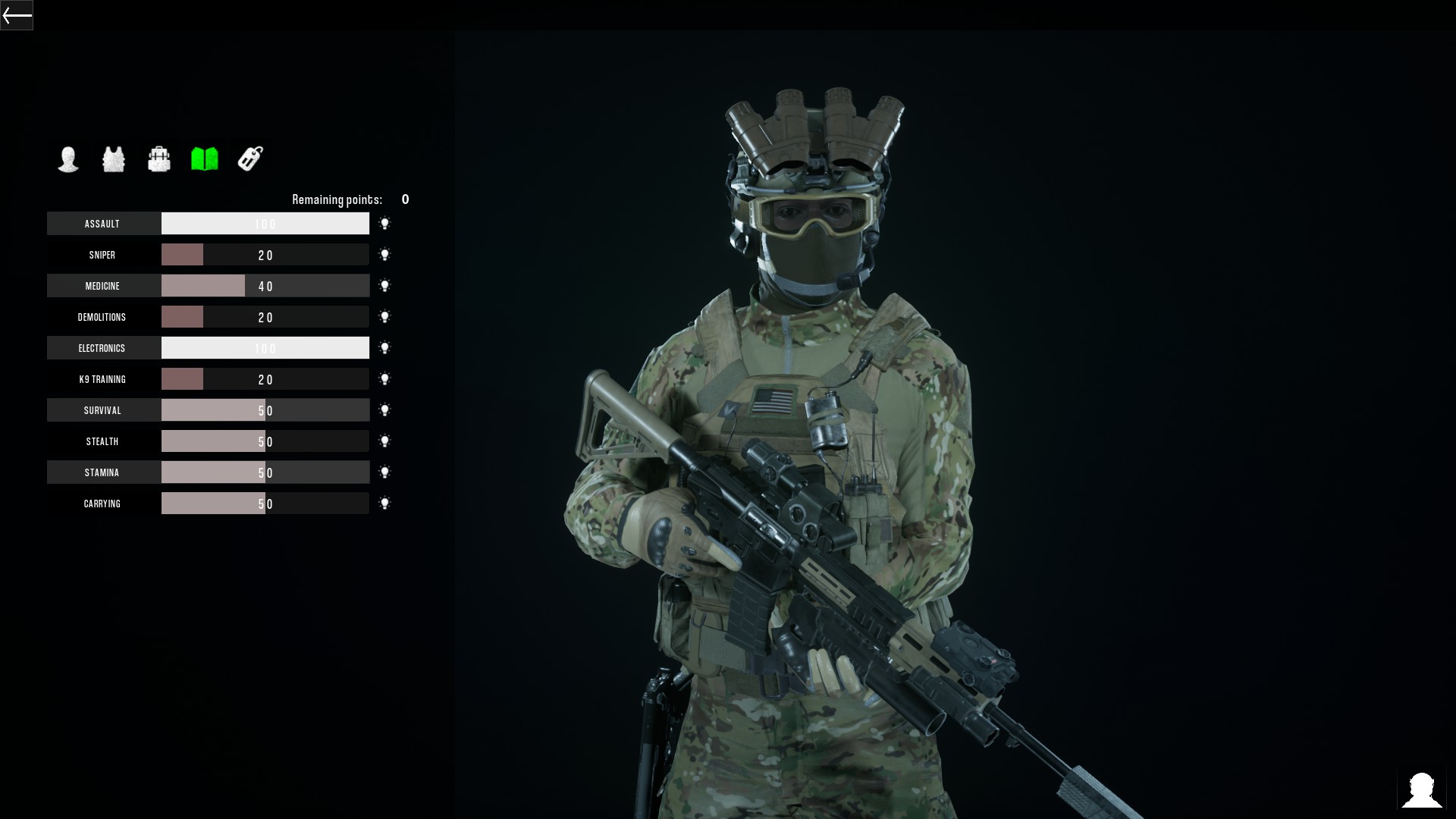 While there are a number of niches your squadmates can fill, there are three essential roles that every squad should have on almost any mission:
While there are a number of niches your squadmates can fill, there are three essential roles that every squad should have on almost any mission:
- Demolitions
- Electronics
- Breacher
These roles are often related to mission tasks or just generally (in the breacher’s case) make life much easier. Let’s break down what exactly they do.
Essential in both defuse and destroy missions, the demolitionist’s job is either to blow things up or stop them from blowing up. Their primary stat is demolitions which allows them to set explosives and defuse explosives more quickly. You’ll generally want them to bring a defuse kit and a placeable explosive such as C4.
Necessary for data decryption, these specialists not only use computers more quickly but are also skilled at cutting power and using the tactical command bridge to call in air support. They should be equipped with an electronics kit and you should consider having your radioman skilled in electronics as well if you decide to bring one.
This role is interesting as it does not have an applicable skill but it does contain gear necessary to get the job done. Lockpicks will get you through a door or window quietly while the break-in kit will get you through it loudly. Another option is to bring a shotgun as they do high damage to doors and serve as the “loud and now” option to dynamic entry.
These roles cover the less essential but still very useful ways you can specialize a squad member. Consider bringing one along if they fit your tactical environment and general style of engagement. Moreover, many of these roles can be combined with the essential roles listed above.
This role can lay down a lot of fire in a short time period. The main drawback of an automatic rifleman is that machine guns are heavy. Even heavier is the ammo they use. You typically don’t want the automatic rifleman filling any role but fire support.
Ammunition is in high demand but it’s also quite heavy. If you plan to be engaged for long periods of time against a high number of enemy combatants, consider bringing someone who can replenish your ammo supply, especially if you don’t have a radioman to call in a supply drop.
Is there a guy way over there causing you issues? Not anymore. The designated marksman can fill a variety of tactical niches to help you towards your objective. Keep one in your fireteam to quickly respond to long range enemies out of your squad’s range. Create a dedicated sniper team to provide overwatch as you move up, taking out nuisance patrols and counter-sniping.
Hey kids, did you like Ghost Recon: Wildlands? The drone operator can operate an aerial drone to spot enemies before approaching. Heavier models are also equipped with night vision and even thermal, giving you a better read on the situation. I often assign this role to the squadleader.
Use an underslung grenade launcher to put explosive rounds way down range. Simple as that.
The dog is an interesting mechanic. It seems trivial at first but don’t discount your furry pal, he has a lot of use. Not only can he sniff out traps, he operates much like D-Dog in MGSV in that he can quietly take out enemies without exposing an operator. He’s a good boy.
Your new best friend. Have you been shot? Exploded? Managed to airstrike yourself? The medic is here to correct this. Carrying the medic pack, the medic has twenty charges of heals and revives to keep you and your squad on your feet.
One of the most important details of breaching rooms is that your barrel length matters. SMGs and assault carbines such as the HK416 have very short barrel length, allowing you to snap on target faster than a long rifle would allow. Consider SMGs, short carbines, shotguns, and pistols for this squadmate. This role can often be combined with one of the essential roles.
Find yourself surrounded? Out of bullets? About to enter an enemy camp but you left your drone back at home? The radioman can call in air strikes, supply drops, and recon drones to help you out of whatever rapidly evolving tactical situation you’ve found yourself in.
“I need the jet! The one that goes BRRRRT!”
This is a highly niche role but it can be a lifesaver on certain CQC missions. The shield makes this role an incredibly hard target, allowing your other teammates to lean around him or fire over him as they make their way down hallways and into rooms.
Game Modes: Pick Your Poison
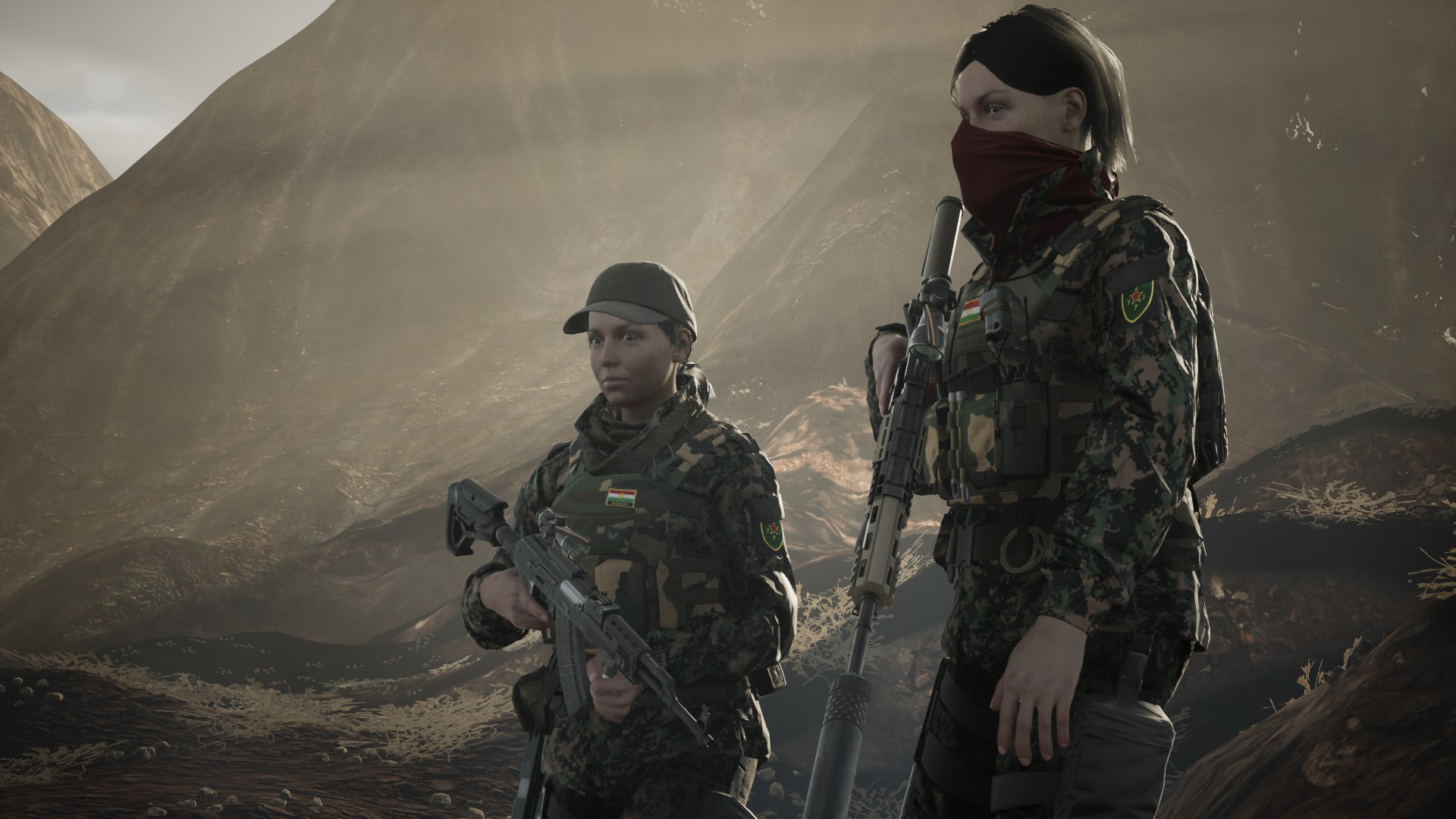 Now you’ve got your own personal squad of high speed, tier one operators (or whatever you came up with). Now it’s time to get them in the field and have them earn that paycheck. This guide will focus primarily on the Spec Ops game mode but let’s go over some of the other options as well.
Now you’ve got your own personal squad of high speed, tier one operators (or whatever you came up with). Now it’s time to get them in the field and have them earn that paycheck. This guide will focus primarily on the Spec Ops game mode but let’s go over some of the other options as well.
This is the hallmark game mode of Black One Blood Brothers. A fully customizable mission over the terrain you choose, the environmental conditions, the objectives, the enemy, the difficulty, and the squad you take.
A stealth mission where you must plant a series of listening devices without being detected or killing an enemy
Chaos incarnate. This mission has you capture three control areas alongside an allied force as they wage intense, map-wide battles against an enemy force. Bring more ammo than you think you need.
The most difficult mode in my opinion. Stranded behind enemy lines without a weapon, you must escape your captors alone. Avoid combat whenever possible.
A survival mode where you must hole up in a defensible position until evac arrives and, here’s the kicker, actually get to the evac point as hundreds of enemies descend upon you. Time until evac and enemy density can be customized.
This is the same as Spec Ops except you’re deployed alone, unable to bring any squadmates.
Spec Ops: Your Own Personal Hell
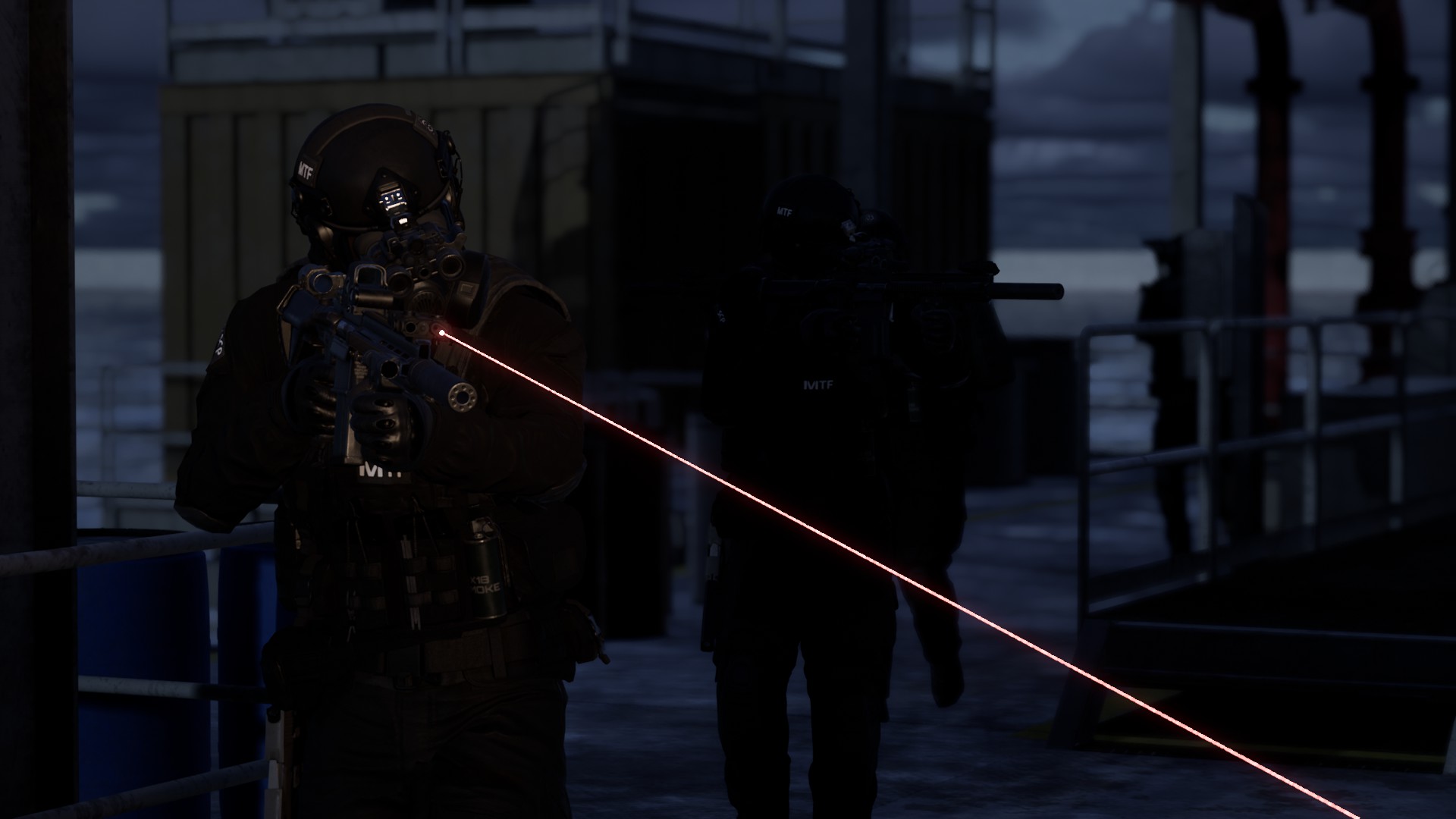 As Spec Ops is the premier game mode of Black One Blood Brothers, let’s break it down. You’ve chosen your game mode, now it’s time to create the mission. Your options include the map, the weather, the music, the enemy, the logistics, the tasks, the difficulty, and your squad.
As Spec Ops is the premier game mode of Black One Blood Brothers, let’s break it down. You’ve chosen your game mode, now it’s time to create the mission. Your options include the map, the weather, the music, the enemy, the logistics, the tasks, the difficulty, and your squad.
-
The Map
Maps are classified as very small, small, medium, large, or very large. Small and very small maps are typically indoors, CQB focused maps while medium, large, and very large maps feature more open operations. Larger maps generally give more XP at the end of the mission. Not every map features the same options for weather and tasks.
-
The Weather
Not only atmospheric, weather can heavily affect AI. Night missions can be the bane of any units without NVGs and provide a killing field for those that have them. Rain and snow reduce visibility and hearing and their storm counterparts, thunderstorm and blizzard, double this. Keep in mind that your squad is also affected by the weather.
-
The Music
This has a little more tactical importance than you think. It’s not just a personal preference but being familiar with the tracks can be an audio cue as to when your engagements begin and end.
-
The Enemy
There are five enemy forces in Black One Blood Brothers
-
The Insurgents
Lightly equipped and barely trained in tactics that involve running directly at you, this is the easiest opposing force to take on.
-
The Rebels
Slightly better equipped than the insurgents, these guys move a bit more intelligently.
-
The Regular Army
Your standard opposing force with decent gear and decent tactical response.
-
The Separatists
Heavy hitters, this force uses some hard hitting equipment and can be tough to take down in alarmed, close quarters engagements.
-
The Dark Army
These guys are mean. They are the best equipped and the best trained out of all enemy forces. You’ll find them with solid hardware and even units with shields. Be advised, many Dark Army units are equipped with NVGs which means they can better detect you at night and can see your IR lasers and flashlights.
-
-
The Logistics
Purely cosmetic, this changes what your insertion vehicles and air support looks like, generally between NATO and Russian aesthetics.
-
The Tasks
Here’s what you’ll actually be doing. Up to six tasks can be chosen in a mission and each task can only be taken once. These tasks can be set as primary or optional with the white and blue crosses respectively. Be advised that Defusing has a time limit while Listening Device and Hostages have fail states if you’re detected with the former’s being guaranteed and the latter’s being potential if you don’t save them in time. Random tasks can also be selected and are worth the most XP.
-
The Difficulty
Here’s where the magic happens. Black One Blood Brothers can be played as an arcade shooter, a hardcore tactical simulator, a literal vision of hell, or anywhere in between based on your selections here. These are split into categories affecting enemy stats, presence, and capabilities, your own user interface, the stats and efficiency of your squad, task accuracy and dynamics, realism controls, and miscellaneous options such as camera use and how “gamey” it will feel. Most of these selections are self-explanatory if you mouse over the lightbulb next to the option so I won’t break down every one but it’s worth looking at a few in particular.
-
Instant Reaction
Choose this if you hate yourself. Enemies will immediately spot you without delay when you’ve entered their vision cone.
-
Cameras
Adds cameras that you’ll have to avoid if you want to remain undetected. While cameras are present in missions and do “detect” you in a sense, I’ve seen no evidence this actually does anything.
-
Alarms
When detected, an alarm can sound and alert all enemies in the area. I’ve seen no actual evidence this works, however.
-
Scramblers
Prevents the use of drones until deactivated.
-
Anti-Air
Prevents the use of air support until destroyed.
-
Traps
Many doors and windows become trapped. This makes K9 units and demolitionists great tools to have so you don’t blow yourself up.
-
Suicide Bombers
Get close to them, they explode. Not great for you.
-
Deathblow
A headshot will kill your operator without an option to revive.
-
True Sight/Accuracy
These settings put your operators on par with the enemy, making their perception and shooting abilities much more realistic based on their equipment, fatigue, injuries, and general sightlines.
-
Magazines
This option makes it so your operators actually consume the magazines in their inventory, meaning they can run out.
-
Task Location
This changes the position of the task marker to be directly on target, in the general vicinity, or nonexistent leaving you to scour the map for your objective.
-
Unforeseen Events
Wildcards, these random events can complicate your mission such as your insertion vehicle being spotted, setting off the alarm before you even hit the ground.
-
Real Aiming
Incredibly important at night, this disables the use of ADS with NVGs equipped, forcing you to point shoot with your IR laser. This means that not only can you not magnify your sights but also NVG equipped enemies will be able to see your IR laser and flashlight.
-
Fatigue/Injuries
Enables the effect of your equipment weight and injuries on your operators capabilities.
-
-
The Squad
This is where you choose which squad to bring, which members to deploy, and can make adjustments if you desire.
Campaign: The Squad Composition Check
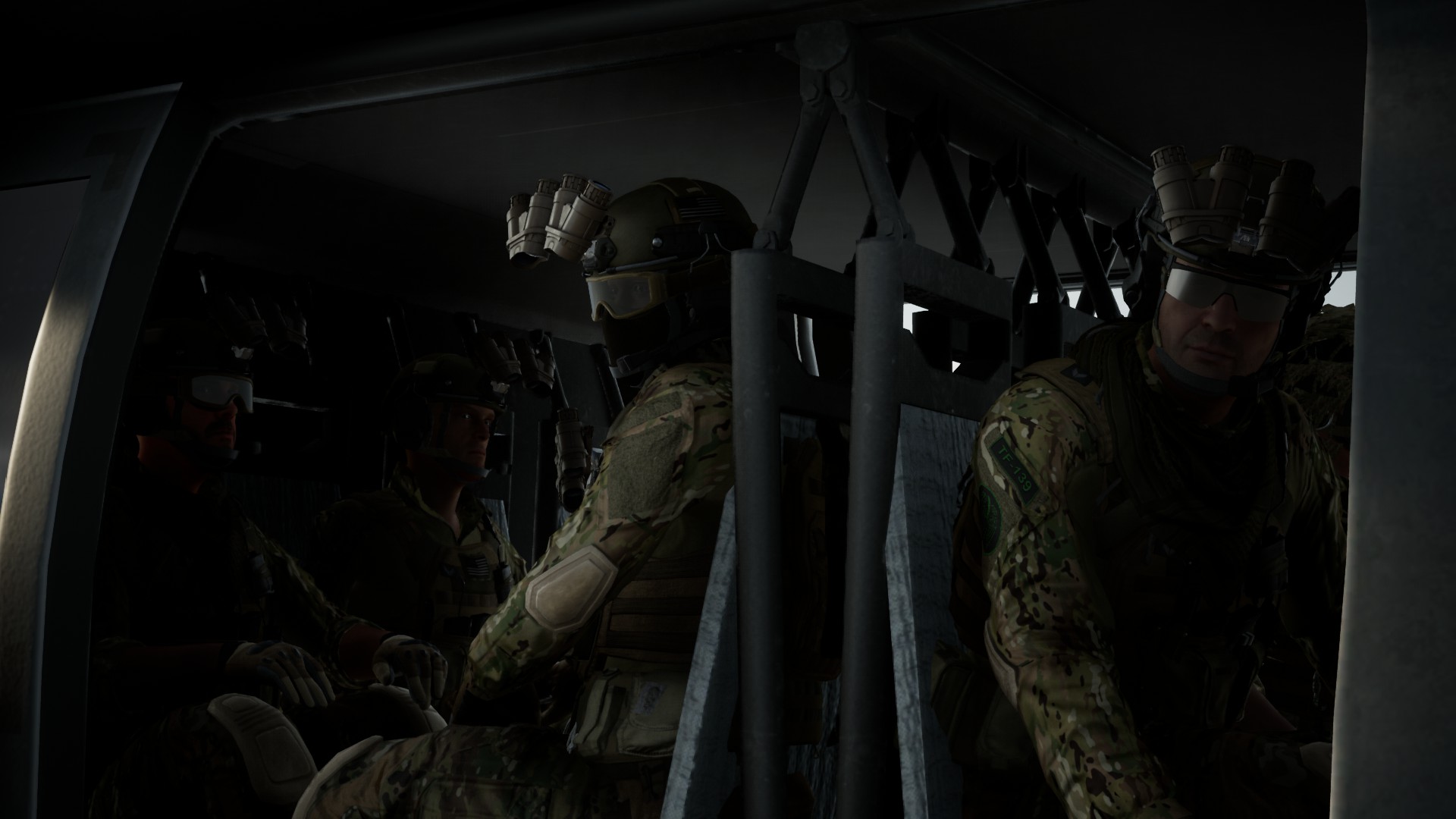 This section isn’t very exhaustive because the campaign of Black One Blood Brothers isn’t all that different from the mission mode. However, there are a few key differences to keep in mind.
This section isn’t very exhaustive because the campaign of Black One Blood Brothers isn’t all that different from the mission mode. However, there are a few key differences to keep in mind.
As opposed to the customized missions you’ve been taking on, these are prebuilt with a ramping difficulty. You’ll be given a general idea of what you’re up against so use your familiarity with the map at hand to customize your loadout before you head in.
Unlike in mission mode, you cannot fine tune the difficulty here. However, I consider each difficulty true to its name. Easy is in fact easy, normal can present you with the occasional challenge, and higher difficulties will really start to test you. Remember to take it slow, play it smart.
When starting the campaign, you lock one of your squads into it. Their clothing and equipment can be changed as the campaign goes on but their physical appearance and skills cannot. If you’re familiar with Rainbow Six 3 or Doorkickers, you’re probably familiar with the idea that a dead operator is dead. Losing an operator loses them for the rest of the campaign and they cannot be replaced. Keep this in mind if your squad has highly specialized skill allocation. If you only had one person who had points in electronics and now they’re dead, someone else will have to take the electronics kit and they may not be any good with it. Lost your sniper but still need overwatch? Hope you have someone with points in sniping. Consider redundancy when building a squad for the campaign.
Squad Command: The Battle Plan & You
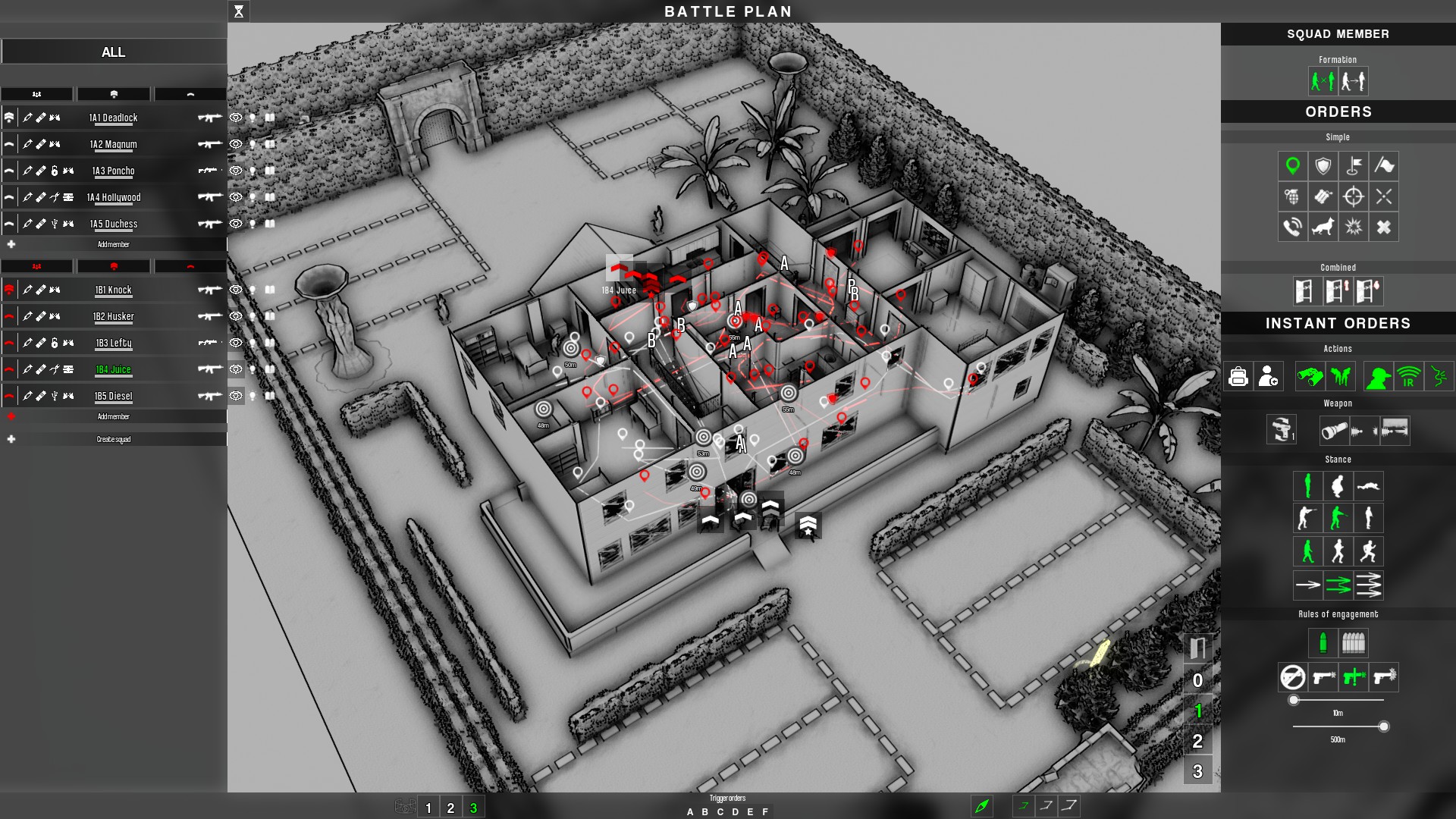
Now you’re on the ground, it’s time to get things done. However, walking directly at your objective in a single file line isn’t exactly the best tactical planning. While you should have a basic understanding of the battle plan from the tutorial, let’s cover a few more intricacies.
It is generally inadvisable, at least in my experience, to keep ten people in one squad. Their pathfinding gets weird, your tactical signature gets much bigger, you’re prone to exploding, and actual battle plans are going to start taking a lot more micromanagement. The best way to handle this is to split them into new squads (clicking them and then clicking the create squad option on the left-side squad manager in the battle plan). Have two elements of five, two fireteams of four and a support team of two, or five teams of two people each. Whichever you prefer and whichever best suits your needs. Want that squad to remain separate but follow you? Select the squad leader and order him to follow player.
With a split squad, you’re now free to approach a target from multiple angles. Have one squad enter the facility from the west side as the other enters from the east. Have one squad descend from the roof while the other comes in from the basement. Have your entry team remain covered by a sniper team. Take your squad to the first objective while the second squad runs across the map to do the other. Your squads are capable soldiers and can get things done very efficiently with the right plan.
When moving a squad as a unit, ensure all subordinates are in formation and then give orders to the squadleader himself. They’ll follow along and stay on him. This improves pathfinding considerably and you only have to keep an eye on one unit as opposed to four or five. That said, there are times when micromanagement is important.
When moving up on a large facility or complicated area, it can be beneficial to order units individually to better slice the pie and cover all angles. If you’re like me and prefer to draw your own breaching plans, setting their exact movement and firing arcs can be lifesaving. Coming up on an enemy position? Consider splitting individually to surround and crush them. Enemy alerted to your presence? Order units individually to windows and doorways, covering angles of approach.
The inbuilt breaching function can seem finicky but most of the time it does work, despite the yellow triangles. In my experience, the breaching commands are best used through quick orders dynamically rather than being used as part of the battle plan. They’re convenient as they allow complex actions such as stacking, opening, grenading, and clearing to be done automatically. This can be done by ordering the entire squad or just the squad leader as the squad will automatically fall in behind him. However, if breaching is part of a bigger plan, you’re best off drawing it yourself.
Use your battle plan or quick order menu to order squad mates to complete objectives without having to approach the object and order them or switch to them and do it yourself. Sometimes missions come down to seconds and the more time you spend fumbling around trying to get them to interact with an objective is more time wasted.
As above, battle happens fast. Rather than switching to them, use your battle plan to have your squad use grenades, set mines, silently take down a soldier with the dog, snipe an enemy, breach a door with a shotgun (shoot a point), call in air support, and set off explosives. If you find yourself in a rapidly evolving combat scenario, you don’t have time to waste swapping between operators.
If you’ve played Rainbow Six 3 or Doorkickers, you’re familiar with go codes and why they’re the best thing in tactical games. You can draw a brilliant plan but go codes are what makes it actually work as they provide the synchronicity you need. Your squad needs to work as a unit even when divided. Approach a house, get in position on two separate doors, call Go Code Alpha when everyone’s ready. The floor is clear, both squads set up at the bottom of two staircases to the next level. Go Code Bravo is called, both squads move up at the same time and clear together. Go codes ensure nothing happens too soon or too late.
Using focus will tell a squad member where to face when he reaches a waypoint. This is essential for covering angles and checking corners. Along with this is Waypoint (Preserve Focus). This allows an operator to move while keeping his muzzle aimed at the focus of his last waypoint. Essential for clearing gaps and keeping your weapon towards the center of the room when moving along walls. An important note is that your focus point is set physically, not just a direction. So if you’re on top of a tower and you set your focus point just ahead of you on the platform, the operator will aim straight. If you set it on the ground, he’ll aim down.
These commands are important as difficulty increases. Turning off squad markers will make your squad nearly invisible to you at night but these IR strobes can help you with IFF so you don’t accidentally shoot your own guys. However, enemies with NVGs can see them too. As for radio communication, remember that enemies are listening for you and so a callout can be heard.
Notice that your units get stuck on staircases, end up on opposite floors, or run around walls when they’re in formation indoors? Set your squad spacing to a 1m column and watch these problems disappear!
Don’t turn yourself and your squad into a statistic by finding an errant mine with your vibram soles or catching a grenade with your face. Spread your squad out in V formation and get some space between them. US Army ATP 3-21.8 recommends 10m intervals.
The more detailed your plan, the more likely you are to survive. Take your time, think it through.
Operational Tips: I’m Up, He Sees Me, I’m Down
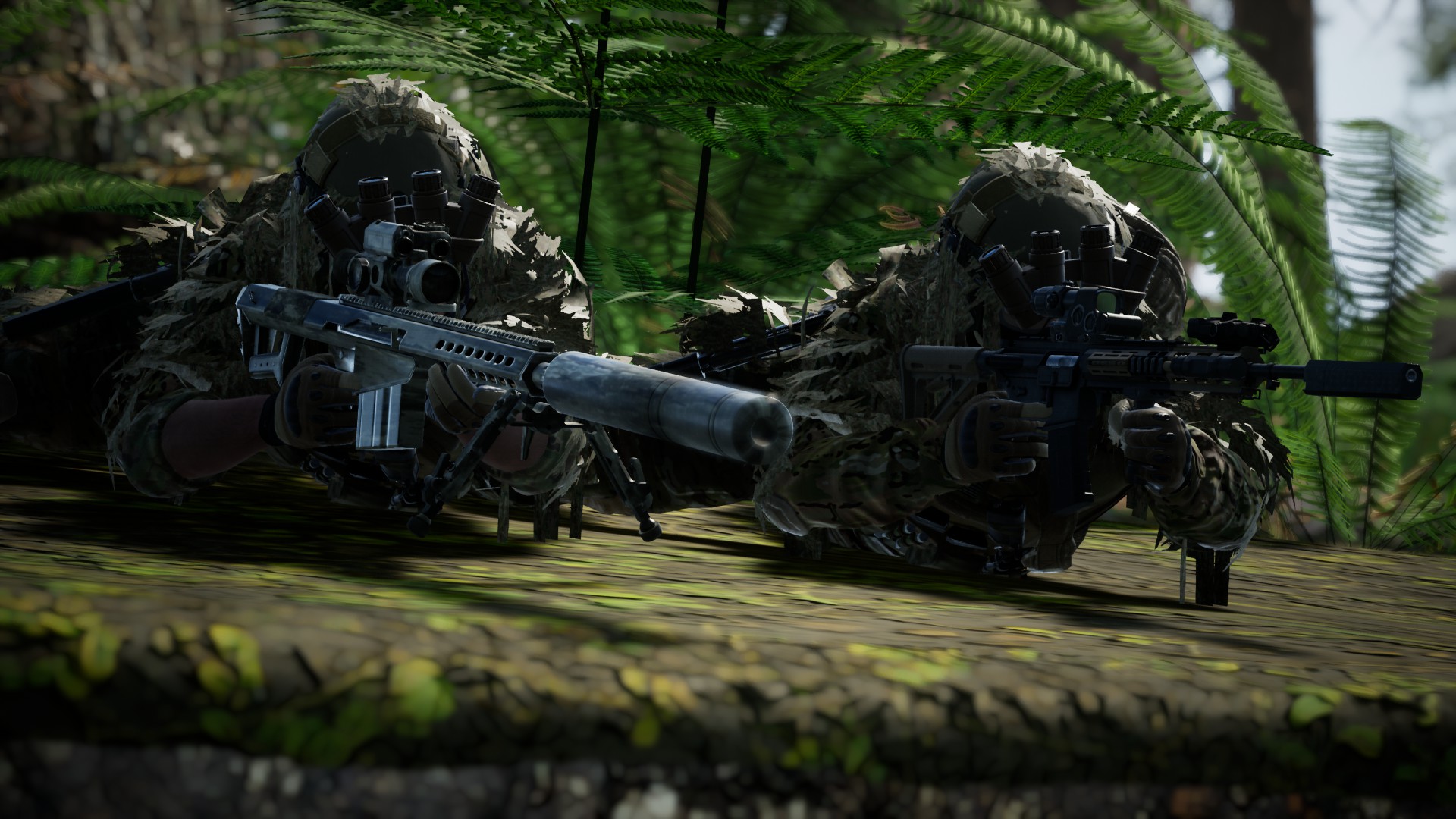 This is a general assortment of tips to help you out when you’re in the field.
This is a general assortment of tips to help you out when you’re in the field.
-
Beware the Dark Army at Night
If you’ve read this guide, you’ve probably picked up on this notion. The Dark Army uses NVGs and can see you and your IR lasers and flashlights at night. Be careful.
-
Mind Your Tells.
IR strobes produce light that can be seen by the Dark Army with NVGs. Radio communications produce noise that can be heard. Your stance affects your visibility while your speed affects your audio signature.
-
Cover vs. Concealment
Keeping yourself in the shadows will make it much harder for an enemy to spot you. Beware the light, especially at night. And remember, thickets are great for concealment but will not stop a round of 7.62. A brick wall will.
-
Check for Traps (Windows Too)
Traps can mean an early and decisive death for you and everyone around you. Check for them and be wary of window traps as well. A round passing through a trapped window will set off one hell of an explosion.
-
Door Locked? Try the Window.
You can climb into first floor windows if they’re unlocked, something that can give you a new point of entry.
-
Bring Ammo. The Correct Ammo.
When you replace an operator’s weapon, the ammo from their original weapon isn’t removed. You can do this by hitting the X at the top of their inventory in the loadout editor to remove unused magazines or drag them out by hand. To add the correct ammo, hit the + button that appears when you mouse over the equipped weapon in the operator’s loadout or drag it in by hand from the ammunition tab.
-
Set Your Animations. Point Your Weapon Forward.
As far as I can tell, this bug will only appear if you’re a long time player who had a squad saved from before custom ready animations were added. If you try to aim your firearm and your character suddenly breaks their arms, aiming at the ground, that means you need to set custom weapon animations from the first section of the character customizer.
-
Don’t Space Waypoints too Far
While using the squadleader for movement commands as discussed in the previous section is reliable, it’s still best not to set waypoints too far apart. Using more waypoints over shorter intervals will help them pathfind.
-
Doorkickers
Approach a door and left click to kick it open for a fast, dynamic entry.
-
Check Your Corners
Check your corners.
-
Spotting Enemies Through Windows
While the AI can often do this, you cannot personally spot an enemy through a closed window by sight or with your drone. However, be advised, the enemy will still gladly shoot you through a closed window. You can spot enemies through open windows.
-
Running Low? Check the Dead.
If you didn’t bring an assistant autorifleman nor a tactical command bridge, you’re going to have to resupply some other way. Check the bodies, see what they’ve got.
-
Go it Alone
Have a particularly dicey task in an enemy compound? Consider leaving the squad behind and going in yourself. Stay low, move decisively, get in, get it done, get out. Channel your inner Big Boss.
-
If You Can See Them, They Can See You
Remember: I’m up, he sees me, I’m down.
The 500,000 XP Mission: Black Day
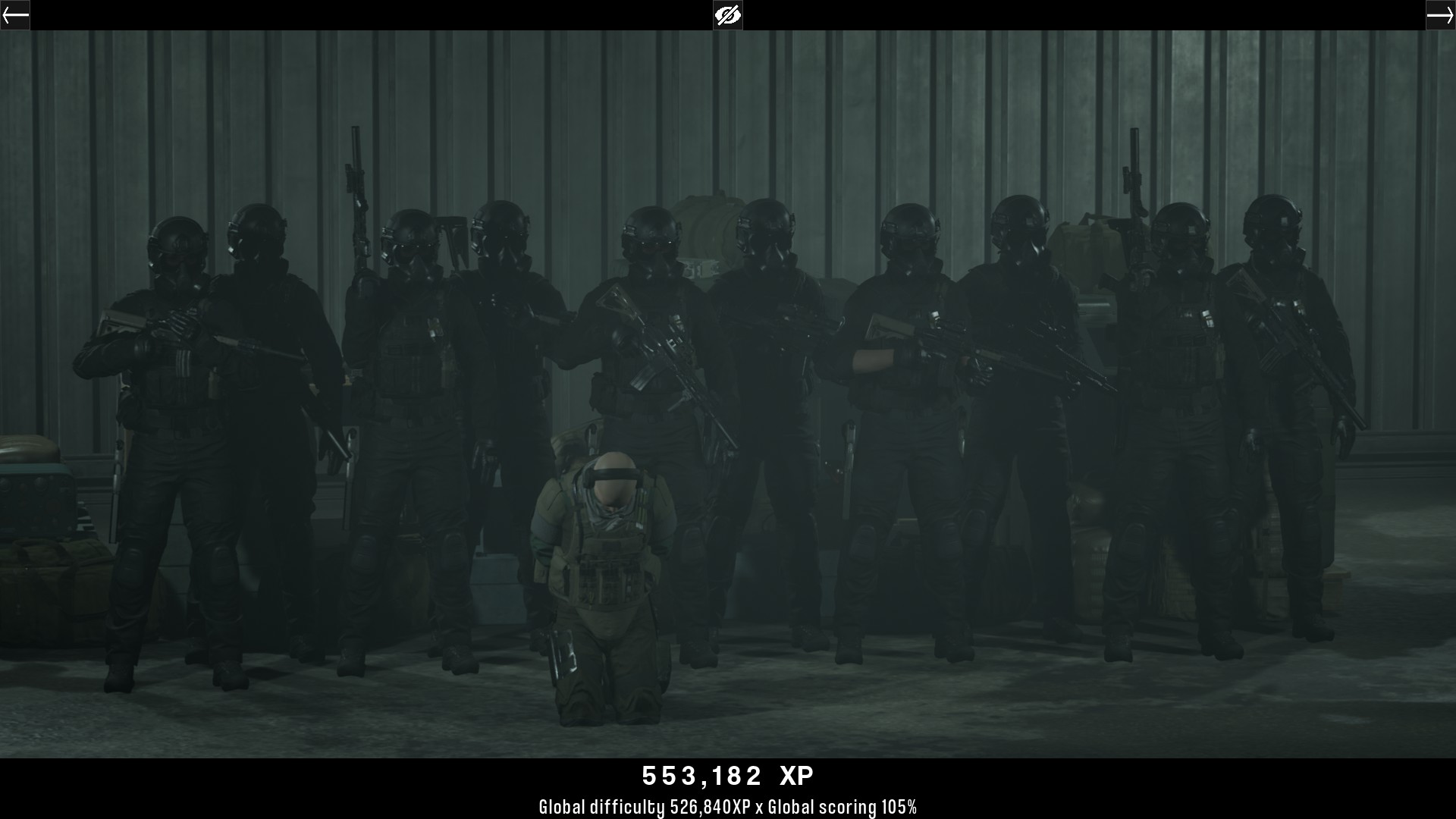
This achievement seems daunting but once you get the hang of the game, it’s perfectly doable and can be done without creating some awful hell mission from which there is no return. Below I’ve set out the mission settings I used for my first 500,000 XP mission to give you an idea of what it’ll take. Feel free to customize it to your liking. Again, while I have cameras and alarms off here, I’m not entirely sure they actually work anyway. Also, remember that you have to 100% the mission for the achievement which requires you to not fail any objectives nor have an operator downed or killed.
Total XP: 532,112
Map: Enila Islands – Talmio
Weather: Night – Bad Weather – Blizzard
Enemy: The Dark Army
Tasks: 6 Random Missions
Squad: 10 Members
Difficulty:
Conclusion: Operating, Operated

And that wraps up our share on General Gameplay Guide & Tips. If you have any additional insights or tips to contribute, don’t hesitate to drop a comment below. For a more in-depth read, you can refer to the original article here by Ogachi, who deserves all the credit. Happy gaming!
